Networking Fundamentals : PDF
VerifiedAdded on 2021/05/31
|12
|2090
|227
AI Summary
Contribute Materials
Your contribution can guide someone’s learning journey. Share your
documents today.

Networking Fundamentals
Student Name
Institution
Student Name
Institution
Secure Best Marks with AI Grader
Need help grading? Try our AI Grader for instant feedback on your assignments.

Introduction
Computer networks is very essential in the operations of many organizations. For
this matter therefore, a proper network design is very critical in ensuring that the
organization executes their operations more effectively and efficiently [1]. The
design should be reliable, easy to monitor and troubleshoot, scalable and most of it
all it should be secure in order to ensure that organizations information is well
protected and not interfered with from unauthorized persons.
The focus of this report therefore is to analyze structure of the e-commerce
company given which is undergoing expansion, evaluate the network design based
on existing networking standards or models such as OSI, the DoD, and the TCP/IP
and determining the transmission media and channels to be used in the new
proposed LAN [2].
Networking Standards
With the expansion of the company, networking standards will be of great help
considering that the company will have to use various networking devices from
different manufacturers depending on the quality and cost of these devices. The
networking standards therefore, will ensure that these devices despite being bought
from different vendor, they work together to ensure that the organization’s network
is more effective and efficient. There are a number of network standards that
enhances interoperability between different networking devices from different
vendors. These standards include the OSI Model, TCP/IP model, among others [4].
Therefore, for this company to implement the new LAN a proper networking
standard that enhances interoperability and compatibility between various installed
devices and infrastructure for the new network, need to be understood and defined.
In this case, a networking standard such as the OSI model which is divided into
layers, will ensure a simplified network design by separating the entire network
communications into small bits that performs different functions. This model will
ensures that various equipment’s such as switches, routers, hubs, network adapters
among others are compatible despite coming from different manufacturers. The OSI
model layers will make it easier for this company to extend their network in future
Computer networks is very essential in the operations of many organizations. For
this matter therefore, a proper network design is very critical in ensuring that the
organization executes their operations more effectively and efficiently [1]. The
design should be reliable, easy to monitor and troubleshoot, scalable and most of it
all it should be secure in order to ensure that organizations information is well
protected and not interfered with from unauthorized persons.
The focus of this report therefore is to analyze structure of the e-commerce
company given which is undergoing expansion, evaluate the network design based
on existing networking standards or models such as OSI, the DoD, and the TCP/IP
and determining the transmission media and channels to be used in the new
proposed LAN [2].
Networking Standards
With the expansion of the company, networking standards will be of great help
considering that the company will have to use various networking devices from
different manufacturers depending on the quality and cost of these devices. The
networking standards therefore, will ensure that these devices despite being bought
from different vendor, they work together to ensure that the organization’s network
is more effective and efficient. There are a number of network standards that
enhances interoperability between different networking devices from different
vendors. These standards include the OSI Model, TCP/IP model, among others [4].
Therefore, for this company to implement the new LAN a proper networking
standard that enhances interoperability and compatibility between various installed
devices and infrastructure for the new network, need to be understood and defined.
In this case, a networking standard such as the OSI model which is divided into
layers, will ensure a simplified network design by separating the entire network
communications into small bits that performs different functions. This model will
ensures that various equipment’s such as switches, routers, hubs, network adapters
among others are compatible despite coming from different manufacturers. The OSI
model layers will make it easier for this company to extend their network in future
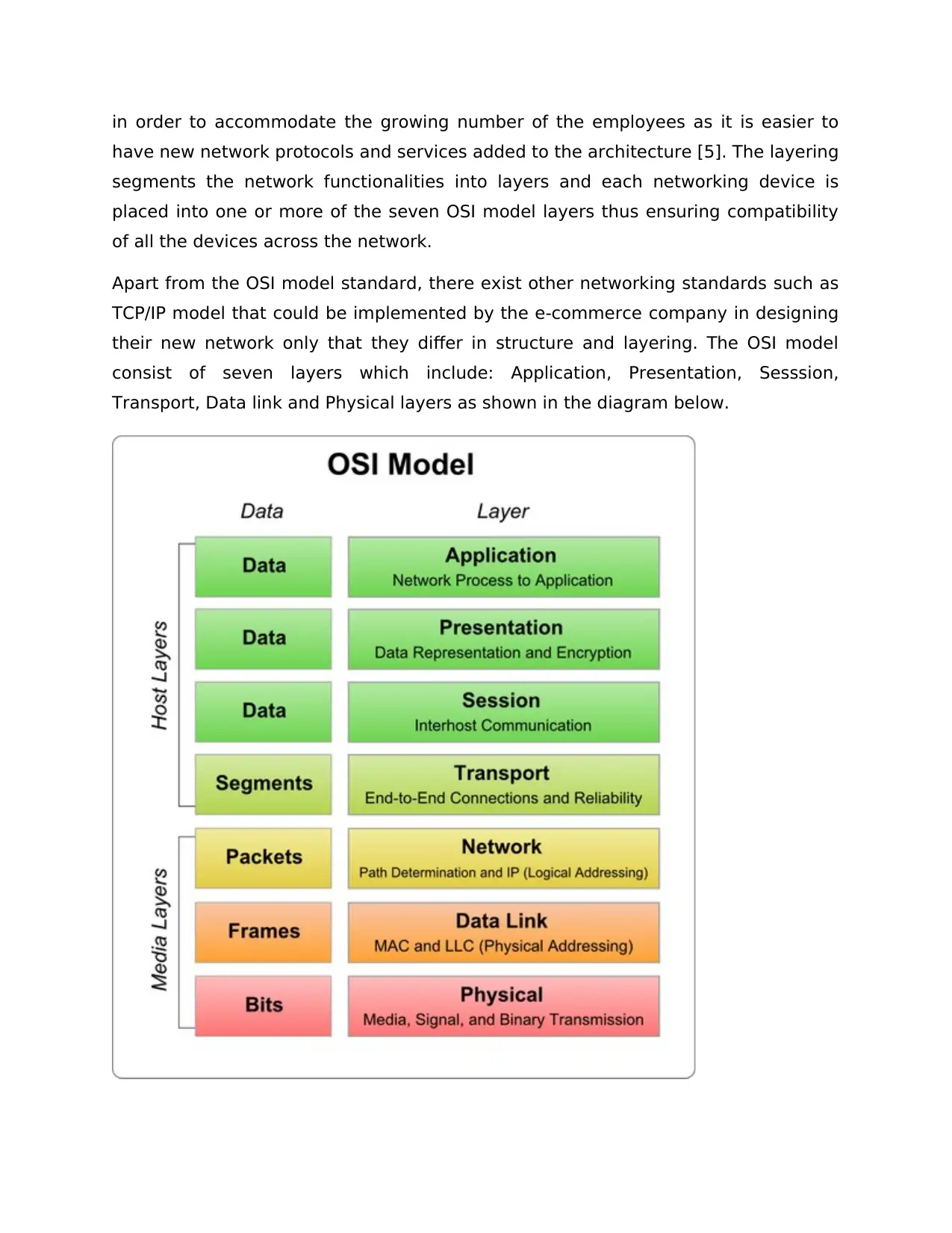
in order to accommodate the growing number of the employees as it is easier to
have new network protocols and services added to the architecture [5]. The layering
segments the network functionalities into layers and each networking device is
placed into one or more of the seven OSI model layers thus ensuring compatibility
of all the devices across the network.
Apart from the OSI model standard, there exist other networking standards such as
TCP/IP model that could be implemented by the e-commerce company in designing
their new network only that they differ in structure and layering. The OSI model
consist of seven layers which include: Application, Presentation, Sesssion,
Transport, Data link and Physical layers as shown in the diagram below.
have new network protocols and services added to the architecture [5]. The layering
segments the network functionalities into layers and each networking device is
placed into one or more of the seven OSI model layers thus ensuring compatibility
of all the devices across the network.
Apart from the OSI model standard, there exist other networking standards such as
TCP/IP model that could be implemented by the e-commerce company in designing
their new network only that they differ in structure and layering. The OSI model
consist of seven layers which include: Application, Presentation, Sesssion,
Transport, Data link and Physical layers as shown in the diagram below.
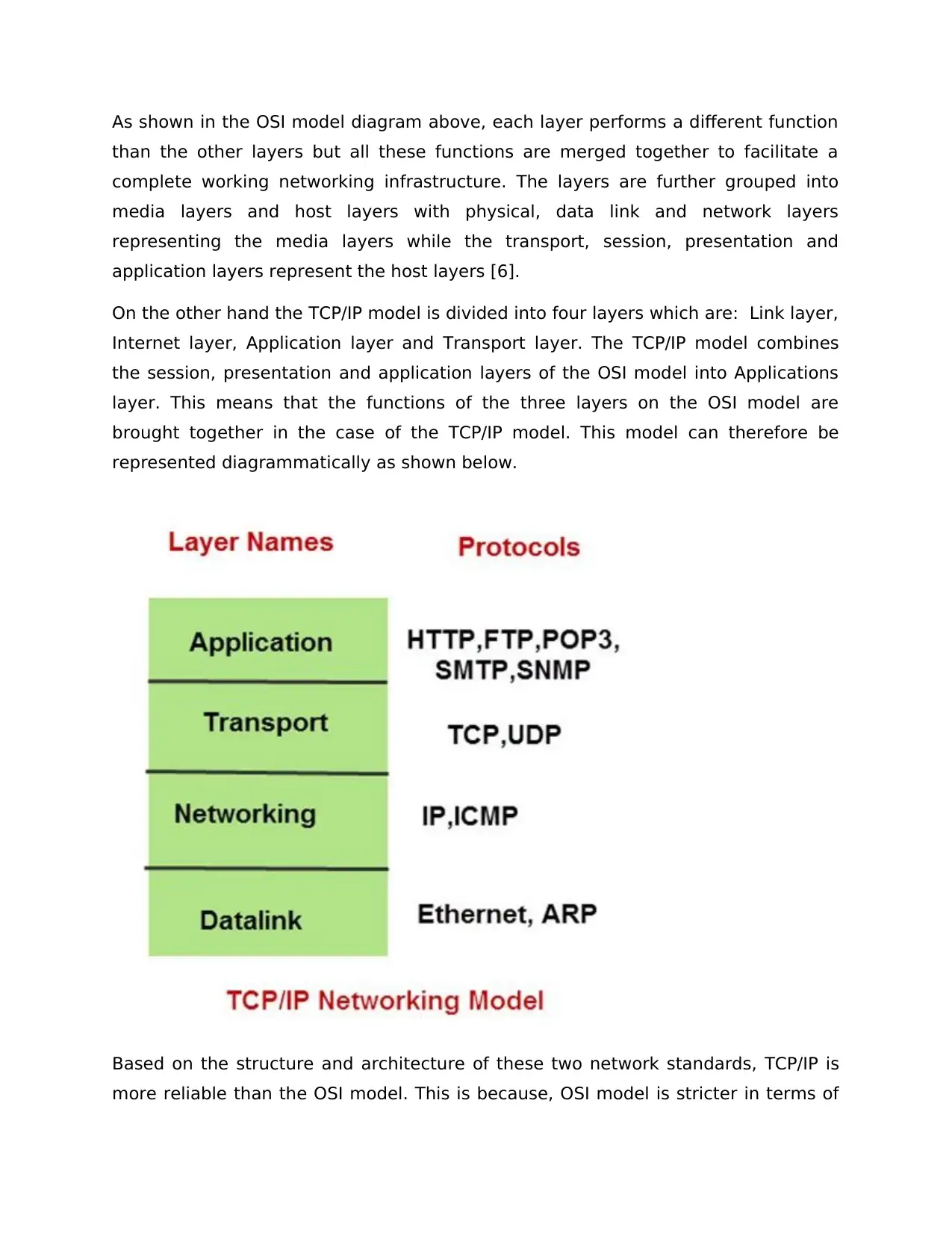
As shown in the OSI model diagram above, each layer performs a different function
than the other layers but all these functions are merged together to facilitate a
complete working networking infrastructure. The layers are further grouped into
media layers and host layers with physical, data link and network layers
representing the media layers while the transport, session, presentation and
application layers represent the host layers [6].
On the other hand the TCP/IP model is divided into four layers which are: Link layer,
Internet layer, Application layer and Transport layer. The TCP/IP model combines
the session, presentation and application layers of the OSI model into Applications
layer. This means that the functions of the three layers on the OSI model are
brought together in the case of the TCP/IP model. This model can therefore be
represented diagrammatically as shown below.
Based on the structure and architecture of these two network standards, TCP/IP is
more reliable than the OSI model. This is because, OSI model is stricter in terms of
than the other layers but all these functions are merged together to facilitate a
complete working networking infrastructure. The layers are further grouped into
media layers and host layers with physical, data link and network layers
representing the media layers while the transport, session, presentation and
application layers represent the host layers [6].
On the other hand the TCP/IP model is divided into four layers which are: Link layer,
Internet layer, Application layer and Transport layer. The TCP/IP model combines
the session, presentation and application layers of the OSI model into Applications
layer. This means that the functions of the three layers on the OSI model are
brought together in the case of the TCP/IP model. This model can therefore be
represented diagrammatically as shown below.
Based on the structure and architecture of these two network standards, TCP/IP is
more reliable than the OSI model. This is because, OSI model is stricter in terms of
Secure Best Marks with AI Grader
Need help grading? Try our AI Grader for instant feedback on your assignments.
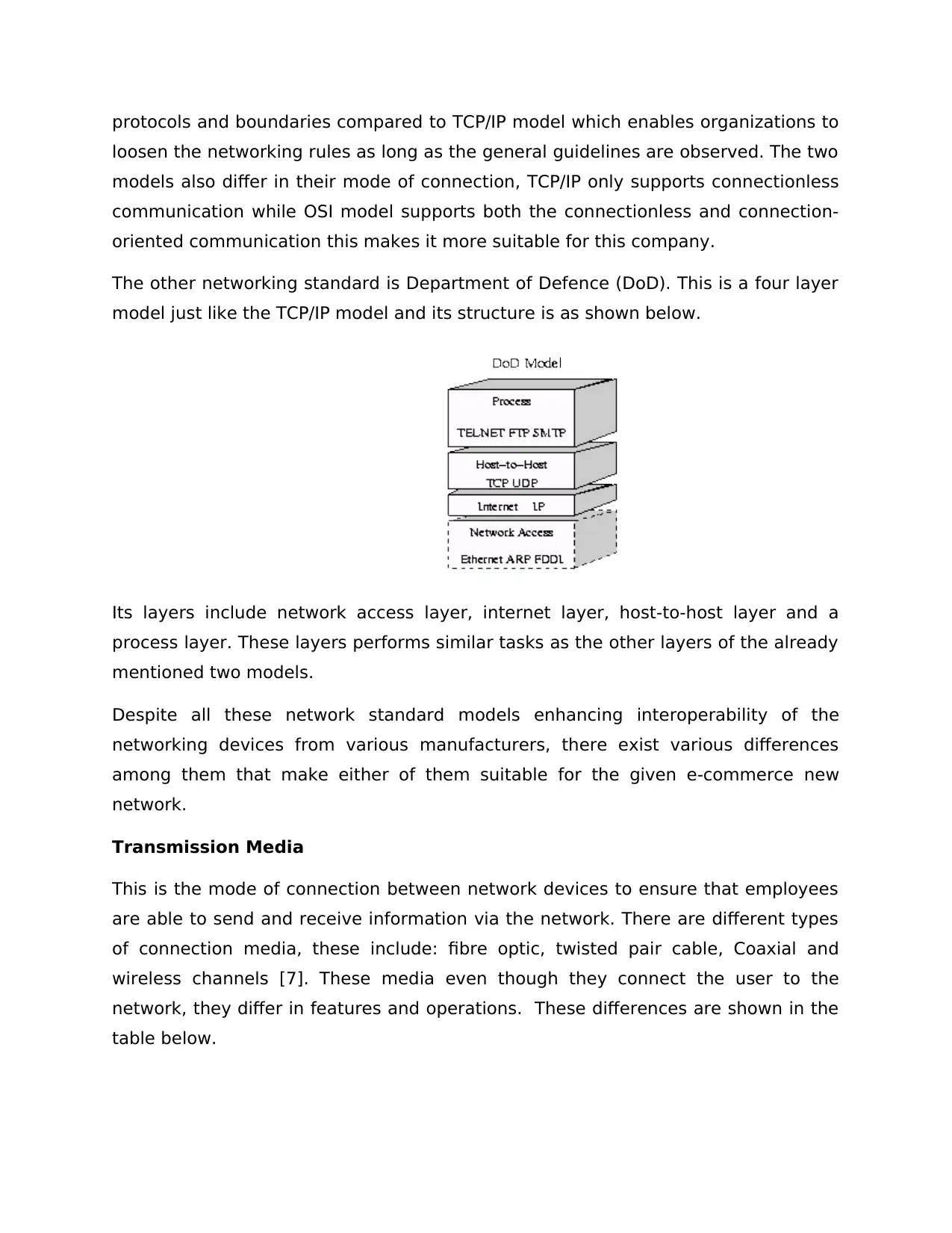
protocols and boundaries compared to TCP/IP model which enables organizations to
loosen the networking rules as long as the general guidelines are observed. The two
models also differ in their mode of connection, TCP/IP only supports connectionless
communication while OSI model supports both the connectionless and connection-
oriented communication this makes it more suitable for this company.
The other networking standard is Department of Defence (DoD). This is a four layer
model just like the TCP/IP model and its structure is as shown below.
Its layers include network access layer, internet layer, host-to-host layer and a
process layer. These layers performs similar tasks as the other layers of the already
mentioned two models.
Despite all these network standard models enhancing interoperability of the
networking devices from various manufacturers, there exist various differences
among them that make either of them suitable for the given e-commerce new
network.
Transmission Media
This is the mode of connection between network devices to ensure that employees
are able to send and receive information via the network. There are different types
of connection media, these include: fibre optic, twisted pair cable, Coaxial and
wireless channels [7]. These media even though they connect the user to the
network, they differ in features and operations. These differences are shown in the
table below.
loosen the networking rules as long as the general guidelines are observed. The two
models also differ in their mode of connection, TCP/IP only supports connectionless
communication while OSI model supports both the connectionless and connection-
oriented communication this makes it more suitable for this company.
The other networking standard is Department of Defence (DoD). This is a four layer
model just like the TCP/IP model and its structure is as shown below.
Its layers include network access layer, internet layer, host-to-host layer and a
process layer. These layers performs similar tasks as the other layers of the already
mentioned two models.
Despite all these network standard models enhancing interoperability of the
networking devices from various manufacturers, there exist various differences
among them that make either of them suitable for the given e-commerce new
network.
Transmission Media
This is the mode of connection between network devices to ensure that employees
are able to send and receive information via the network. There are different types
of connection media, these include: fibre optic, twisted pair cable, Coaxial and
wireless channels [7]. These media even though they connect the user to the
network, they differ in features and operations. These differences are shown in the
table below.
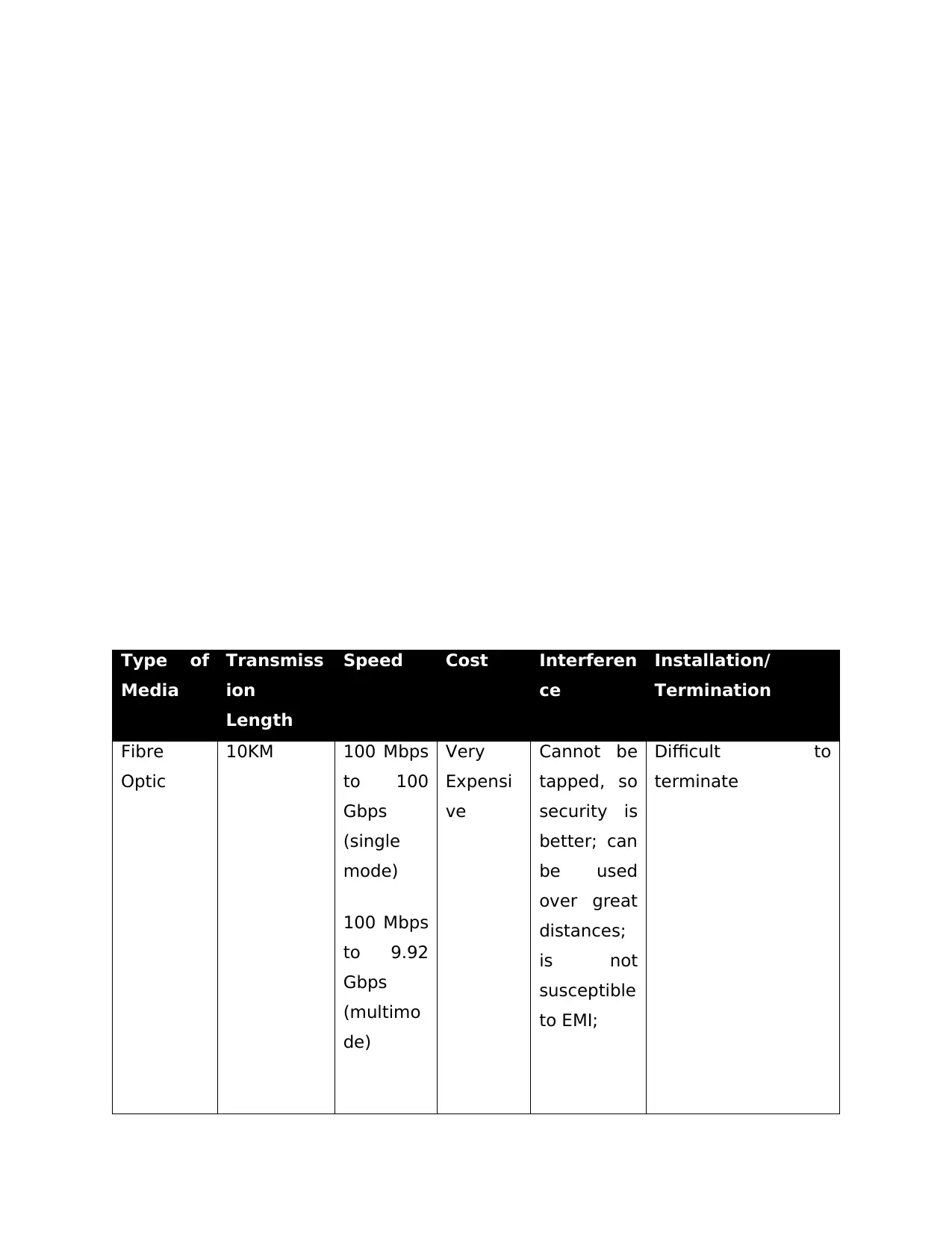
Type of
Media
Transmiss
ion
Length
Speed Cost Interferen
ce
Installation/
Termination
Fibre
Optic
10KM 100 Mbps
to 100
Gbps
(single
mode)
100 Mbps
to 9.92
Gbps
(multimo
de)
Very
Expensi
ve
Cannot be
tapped, so
security is
better; can
be used
over great
distances;
is not
susceptible
to EMI;
Difficult to
terminate
Media
Transmiss
ion
Length
Speed Cost Interferen
ce
Installation/
Termination
Fibre
Optic
10KM 100 Mbps
to 100
Gbps
(single
mode)
100 Mbps
to 9.92
Gbps
(multimo
de)
Very
Expensi
ve
Cannot be
tapped, so
security is
better; can
be used
over great
distances;
is not
susceptible
to EMI;
Difficult to
terminate

Twisted
Pair Cable
100m 10 Mbps
to 100
Mbps
Less
Expensi
ve
Reduced
crosstalk;
less
resistant to
EMI.
Easy to Install
Coaxial 500m 10 Mbps
to 100
Mbps
Less
Expensi
ve
Less
susceptible
to EMI
interferenc
e than
other types
of copper
media
Easy to Install
The wireless media do not require any physical connections, the networking devices
only need a wireless adapter card to connect to the access point. This makes this
mode of transmission more versatile in designing organization’s network.
Considering the size and physical structure of this company, the best transmission
media will be the use of coaxial cables. These cables are less expensive and are
easy to install compared to fibre optics. The cost of this cable is also within the
company’s budget and the fact that it transmit up to 500m makes it even more
suitable since the company has moved to a three-floor building. Another feature of
this transmission media is the fact that it is not easily affected by the EMI than
twisted pair cables this means that there will be reduced or no interruption during
the transmission process thus making it more effective. It is also easy to terminate
coaxial cable and this makes the installation process easier and faster.
Connection Mode
The company will need a connection that transmit data at a higher speed
considering the amount of information being sent to the backup site [8]. For that
case a synchronous connection will be suitable for this company compared to
asynchronous connection [9]. This is because with synchronous connection the
Pair Cable
100m 10 Mbps
to 100
Mbps
Less
Expensi
ve
Reduced
crosstalk;
less
resistant to
EMI.
Easy to Install
Coaxial 500m 10 Mbps
to 100
Mbps
Less
Expensi
ve
Less
susceptible
to EMI
interferenc
e than
other types
of copper
media
Easy to Install
The wireless media do not require any physical connections, the networking devices
only need a wireless adapter card to connect to the access point. This makes this
mode of transmission more versatile in designing organization’s network.
Considering the size and physical structure of this company, the best transmission
media will be the use of coaxial cables. These cables are less expensive and are
easy to install compared to fibre optics. The cost of this cable is also within the
company’s budget and the fact that it transmit up to 500m makes it even more
suitable since the company has moved to a three-floor building. Another feature of
this transmission media is the fact that it is not easily affected by the EMI than
twisted pair cables this means that there will be reduced or no interruption during
the transmission process thus making it more effective. It is also easy to terminate
coaxial cable and this makes the installation process easier and faster.
Connection Mode
The company will need a connection that transmit data at a higher speed
considering the amount of information being sent to the backup site [8]. For that
case a synchronous connection will be suitable for this company compared to
asynchronous connection [9]. This is because with synchronous connection the
Paraphrase This Document
Need a fresh take? Get an instant paraphrase of this document with our AI Paraphraser
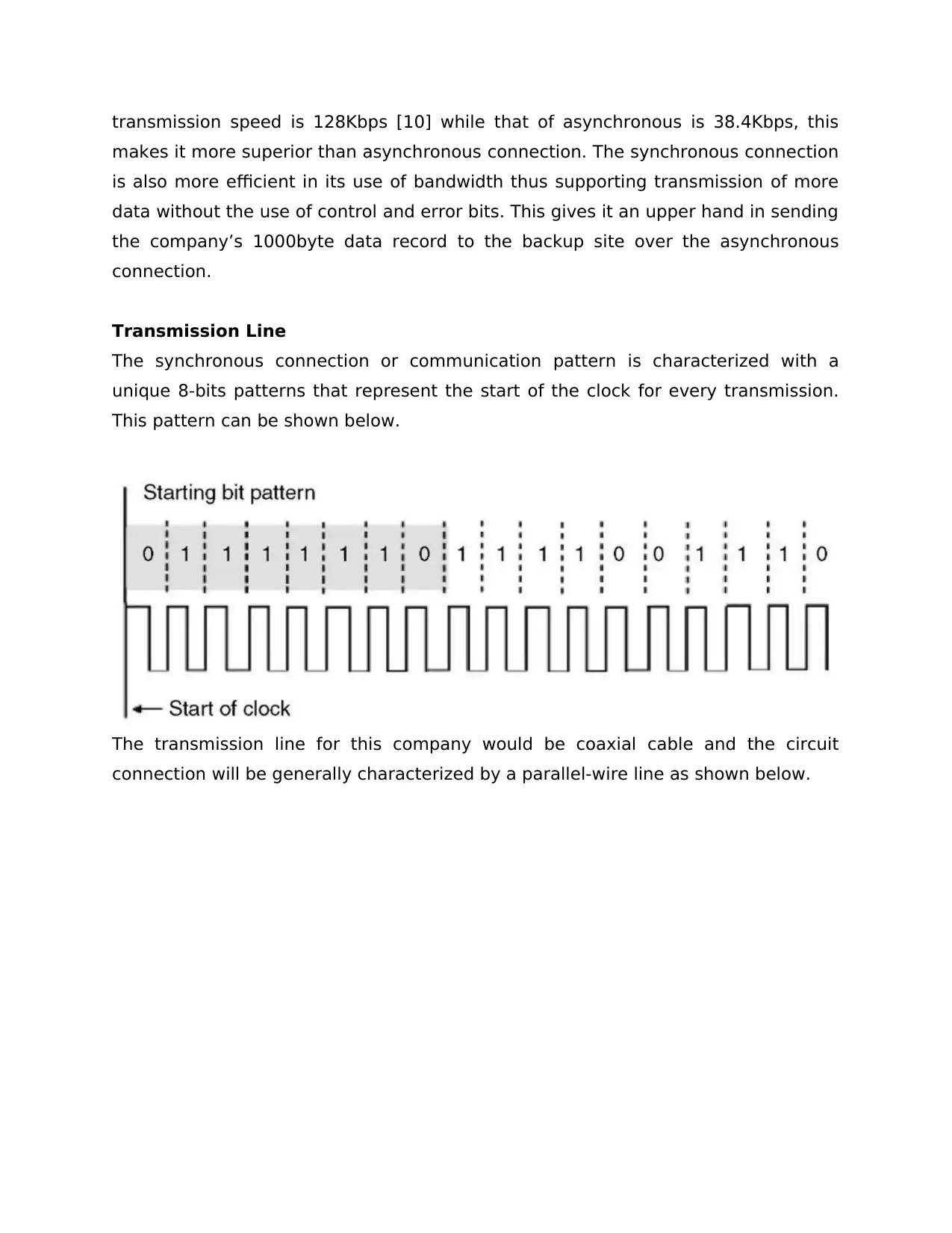
transmission speed is 128Kbps [10] while that of asynchronous is 38.4Kbps, this
makes it more superior than asynchronous connection. The synchronous connection
is also more efficient in its use of bandwidth thus supporting transmission of more
data without the use of control and error bits. This gives it an upper hand in sending
the company’s 1000byte data record to the backup site over the asynchronous
connection.
Transmission Line
The synchronous connection or communication pattern is characterized with a
unique 8-bits patterns that represent the start of the clock for every transmission.
This pattern can be shown below.
The transmission line for this company would be coaxial cable and the circuit
connection will be generally characterized by a parallel-wire line as shown below.
makes it more superior than asynchronous connection. The synchronous connection
is also more efficient in its use of bandwidth thus supporting transmission of more
data without the use of control and error bits. This gives it an upper hand in sending
the company’s 1000byte data record to the backup site over the asynchronous
connection.
Transmission Line
The synchronous connection or communication pattern is characterized with a
unique 8-bits patterns that represent the start of the clock for every transmission.
This pattern can be shown below.
The transmission line for this company would be coaxial cable and the circuit
connection will be generally characterized by a parallel-wire line as shown below.
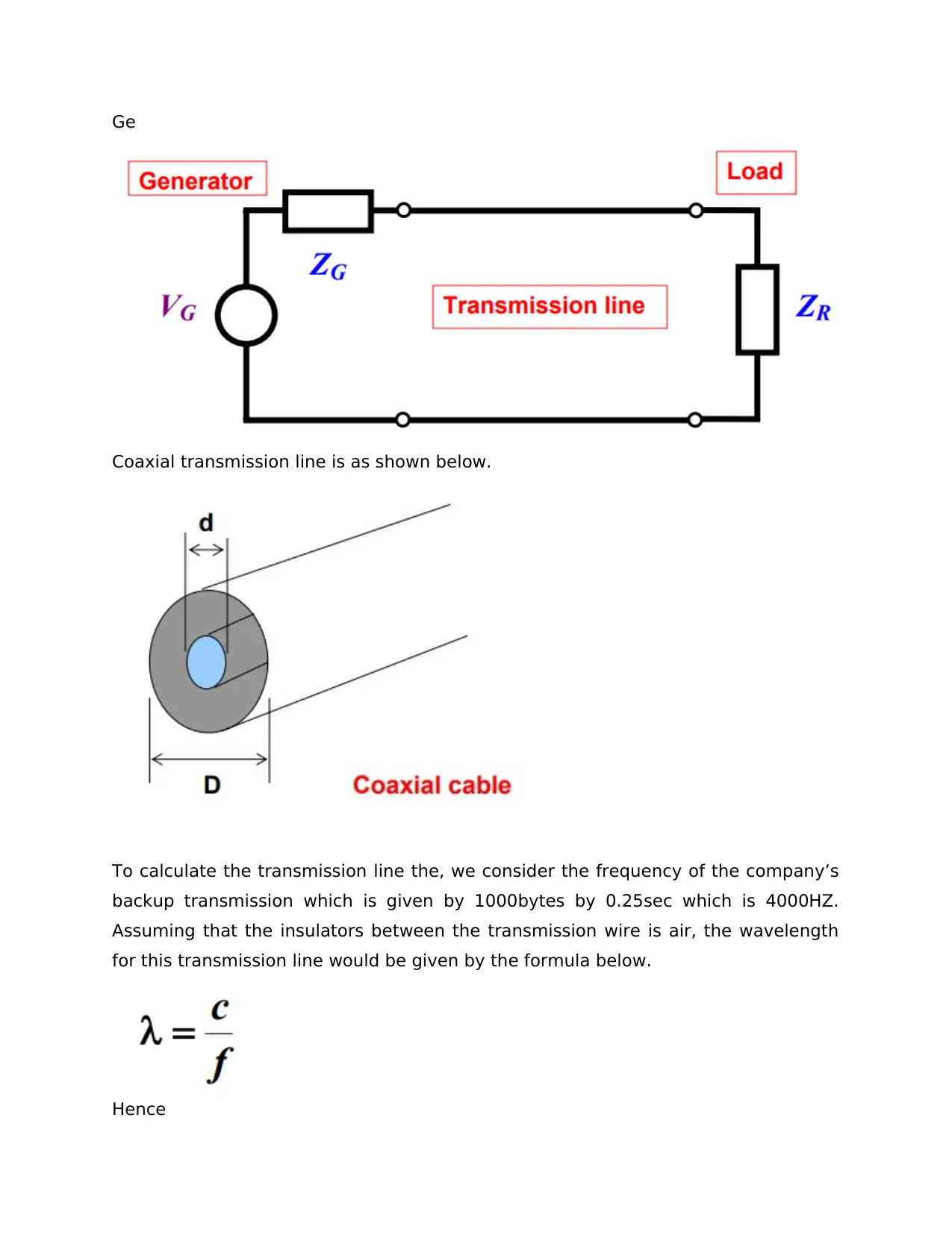
Ge
Coaxial transmission line is as shown below.
To calculate the transmission line the, we consider the frequency of the company’s
backup transmission which is given by 1000bytes by 0.25sec which is 4000HZ.
Assuming that the insulators between the transmission wire is air, the wavelength
for this transmission line would be given by the formula below.
Hence
Coaxial transmission line is as shown below.
To calculate the transmission line the, we consider the frequency of the company’s
backup transmission which is given by 1000bytes by 0.25sec which is 4000HZ.
Assuming that the insulators between the transmission wire is air, the wavelength
for this transmission line would be given by the formula below.
Hence
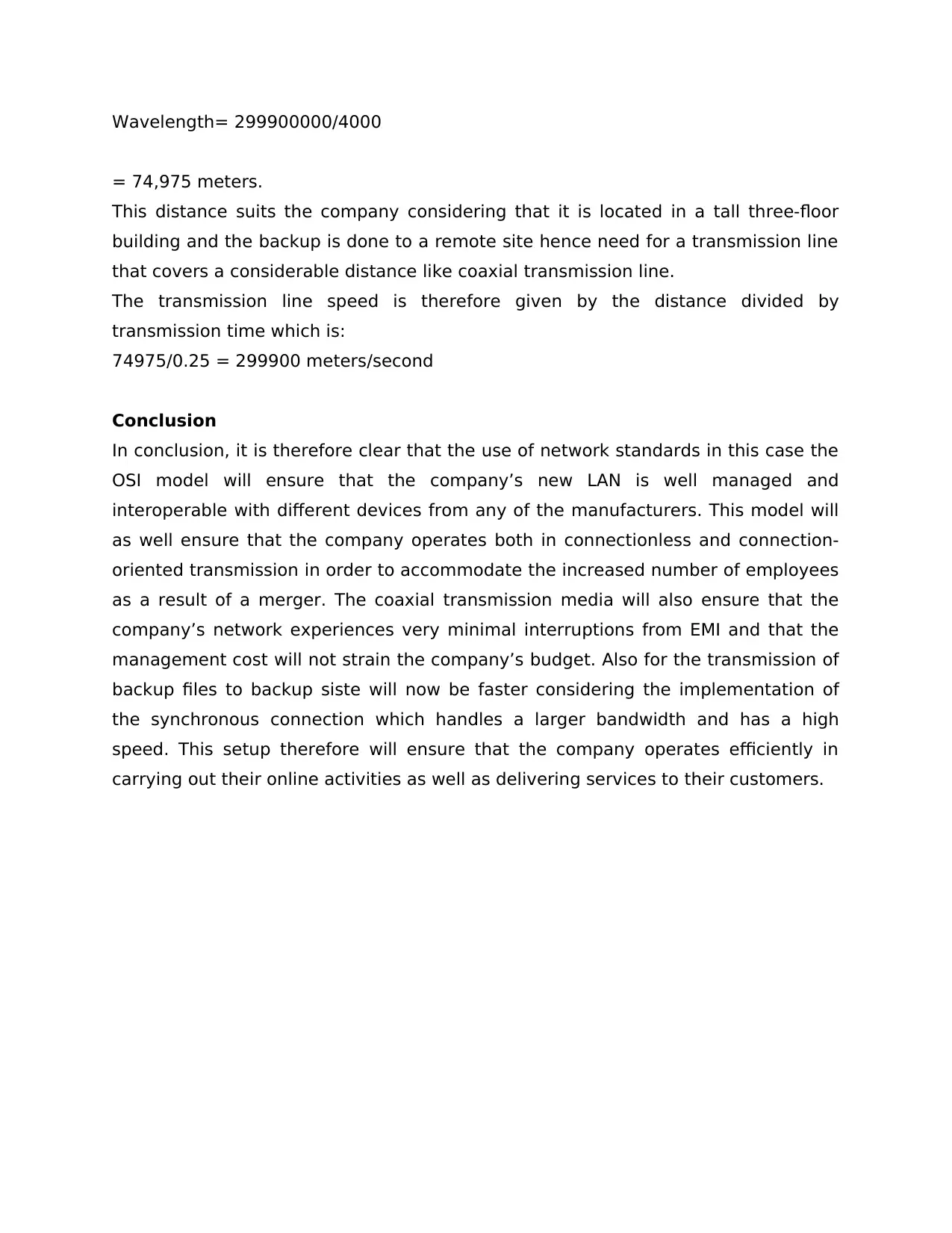
Wavelength= 299900000/4000
= 74,975 meters.
This distance suits the company considering that it is located in a tall three-floor
building and the backup is done to a remote site hence need for a transmission line
that covers a considerable distance like coaxial transmission line.
The transmission line speed is therefore given by the distance divided by
transmission time which is:
74975/0.25 = 299900 meters/second
Conclusion
In conclusion, it is therefore clear that the use of network standards in this case the
OSI model will ensure that the company’s new LAN is well managed and
interoperable with different devices from any of the manufacturers. This model will
as well ensure that the company operates both in connectionless and connection-
oriented transmission in order to accommodate the increased number of employees
as a result of a merger. The coaxial transmission media will also ensure that the
company’s network experiences very minimal interruptions from EMI and that the
management cost will not strain the company’s budget. Also for the transmission of
backup files to backup siste will now be faster considering the implementation of
the synchronous connection which handles a larger bandwidth and has a high
speed. This setup therefore will ensure that the company operates efficiently in
carrying out their online activities as well as delivering services to their customers.
= 74,975 meters.
This distance suits the company considering that it is located in a tall three-floor
building and the backup is done to a remote site hence need for a transmission line
that covers a considerable distance like coaxial transmission line.
The transmission line speed is therefore given by the distance divided by
transmission time which is:
74975/0.25 = 299900 meters/second
Conclusion
In conclusion, it is therefore clear that the use of network standards in this case the
OSI model will ensure that the company’s new LAN is well managed and
interoperable with different devices from any of the manufacturers. This model will
as well ensure that the company operates both in connectionless and connection-
oriented transmission in order to accommodate the increased number of employees
as a result of a merger. The coaxial transmission media will also ensure that the
company’s network experiences very minimal interruptions from EMI and that the
management cost will not strain the company’s budget. Also for the transmission of
backup files to backup siste will now be faster considering the implementation of
the synchronous connection which handles a larger bandwidth and has a high
speed. This setup therefore will ensure that the company operates efficiently in
carrying out their online activities as well as delivering services to their customers.
Secure Best Marks with AI Grader
Need help grading? Try our AI Grader for instant feedback on your assignments.
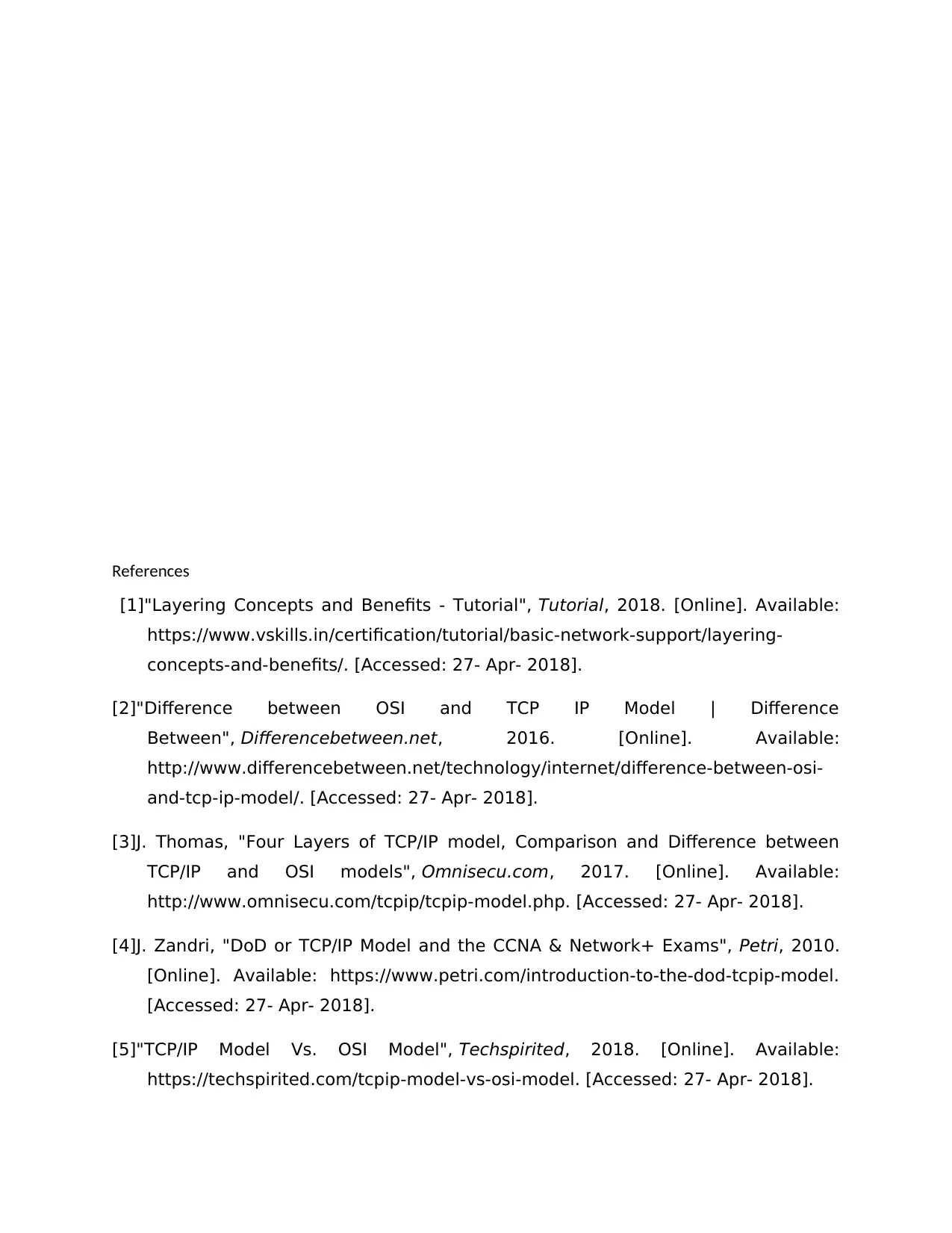
References
[1]"Layering Concepts and Benefits - Tutorial", Tutorial, 2018. [Online]. Available:
https://www.vskills.in/certification/tutorial/basic-network-support/layering-
concepts-and-benefits/. [Accessed: 27- Apr- 2018].
[2]"Difference between OSI and TCP IP Model | Difference
Between", Differencebetween.net, 2016. [Online]. Available:
http://www.differencebetween.net/technology/internet/difference-between-osi-
and-tcp-ip-model/. [Accessed: 27- Apr- 2018].
[3]J. Thomas, "Four Layers of TCP/IP model, Comparison and Difference between
TCP/IP and OSI models", Omnisecu.com, 2017. [Online]. Available:
http://www.omnisecu.com/tcpip/tcpip-model.php. [Accessed: 27- Apr- 2018].
[4]J. Zandri, "DoD or TCP/IP Model and the CCNA & Network+ Exams", Petri, 2010.
[Online]. Available: https://www.petri.com/introduction-to-the-dod-tcpip-model.
[Accessed: 27- Apr- 2018].
[5]"TCP/IP Model Vs. OSI Model", Techspirited, 2018. [Online]. Available:
https://techspirited.com/tcpip-model-vs-osi-model. [Accessed: 27- Apr- 2018].
[1]"Layering Concepts and Benefits - Tutorial", Tutorial, 2018. [Online]. Available:
https://www.vskills.in/certification/tutorial/basic-network-support/layering-
concepts-and-benefits/. [Accessed: 27- Apr- 2018].
[2]"Difference between OSI and TCP IP Model | Difference
Between", Differencebetween.net, 2016. [Online]. Available:
http://www.differencebetween.net/technology/internet/difference-between-osi-
and-tcp-ip-model/. [Accessed: 27- Apr- 2018].
[3]J. Thomas, "Four Layers of TCP/IP model, Comparison and Difference between
TCP/IP and OSI models", Omnisecu.com, 2017. [Online]. Available:
http://www.omnisecu.com/tcpip/tcpip-model.php. [Accessed: 27- Apr- 2018].
[4]J. Zandri, "DoD or TCP/IP Model and the CCNA & Network+ Exams", Petri, 2010.
[Online]. Available: https://www.petri.com/introduction-to-the-dod-tcpip-model.
[Accessed: 27- Apr- 2018].
[5]"TCP/IP Model Vs. OSI Model", Techspirited, 2018. [Online]. Available:
https://techspirited.com/tcpip-model-vs-osi-model. [Accessed: 27- Apr- 2018].
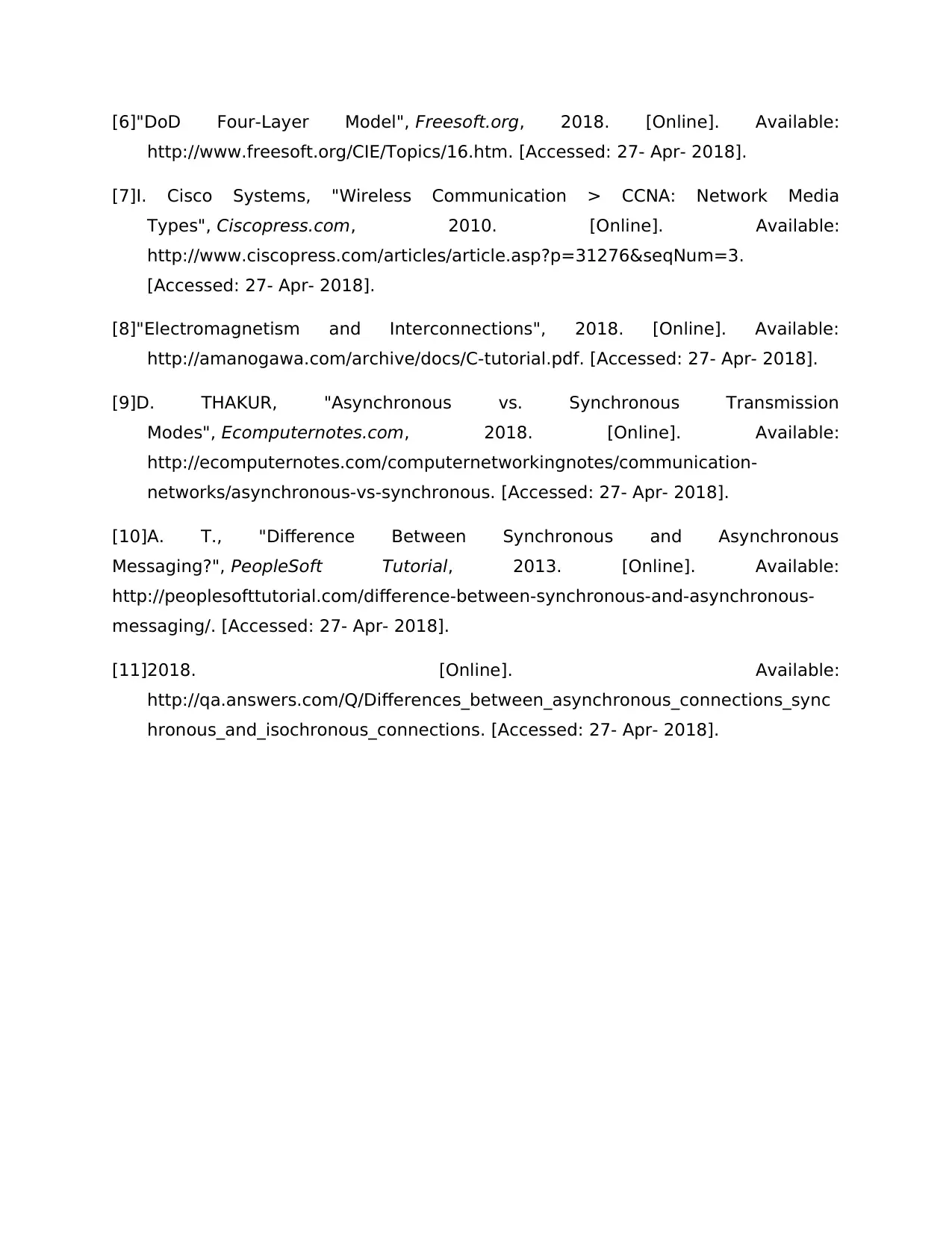
[6]"DoD Four-Layer Model", Freesoft.org, 2018. [Online]. Available:
http://www.freesoft.org/CIE/Topics/16.htm. [Accessed: 27- Apr- 2018].
[7]I. Cisco Systems, "Wireless Communication > CCNA: Network Media
Types", Ciscopress.com, 2010. [Online]. Available:
http://www.ciscopress.com/articles/article.asp?p=31276&seqNum=3.
[Accessed: 27- Apr- 2018].
[8]"Electromagnetism and Interconnections", 2018. [Online]. Available:
http://amanogawa.com/archive/docs/C-tutorial.pdf. [Accessed: 27- Apr- 2018].
[9]D. THAKUR, "Asynchronous vs. Synchronous Transmission
Modes", Ecomputernotes.com, 2018. [Online]. Available:
http://ecomputernotes.com/computernetworkingnotes/communication-
networks/asynchronous-vs-synchronous. [Accessed: 27- Apr- 2018].
[10]A. T., "Difference Between Synchronous and Asynchronous
Messaging?", PeopleSoft Tutorial, 2013. [Online]. Available:
http://peoplesofttutorial.com/difference-between-synchronous-and-asynchronous-
messaging/. [Accessed: 27- Apr- 2018].
[11]2018. [Online]. Available:
http://qa.answers.com/Q/Differences_between_asynchronous_connections_sync
hronous_and_isochronous_connections. [Accessed: 27- Apr- 2018].
http://www.freesoft.org/CIE/Topics/16.htm. [Accessed: 27- Apr- 2018].
[7]I. Cisco Systems, "Wireless Communication > CCNA: Network Media
Types", Ciscopress.com, 2010. [Online]. Available:
http://www.ciscopress.com/articles/article.asp?p=31276&seqNum=3.
[Accessed: 27- Apr- 2018].
[8]"Electromagnetism and Interconnections", 2018. [Online]. Available:
http://amanogawa.com/archive/docs/C-tutorial.pdf. [Accessed: 27- Apr- 2018].
[9]D. THAKUR, "Asynchronous vs. Synchronous Transmission
Modes", Ecomputernotes.com, 2018. [Online]. Available:
http://ecomputernotes.com/computernetworkingnotes/communication-
networks/asynchronous-vs-synchronous. [Accessed: 27- Apr- 2018].
[10]A. T., "Difference Between Synchronous and Asynchronous
Messaging?", PeopleSoft Tutorial, 2013. [Online]. Available:
http://peoplesofttutorial.com/difference-between-synchronous-and-asynchronous-
messaging/. [Accessed: 27- Apr- 2018].
[11]2018. [Online]. Available:
http://qa.answers.com/Q/Differences_between_asynchronous_connections_sync
hronous_and_isochronous_connections. [Accessed: 27- Apr- 2018].
1 out of 12
Related Documents
Your All-in-One AI-Powered Toolkit for Academic Success.
+13062052269
info@desklib.com
Available 24*7 on WhatsApp / Email
![[object Object]](/_next/static/media/star-bottom.7253800d.svg)
Unlock your academic potential
© 2024 | Zucol Services PVT LTD | All rights reserved.





